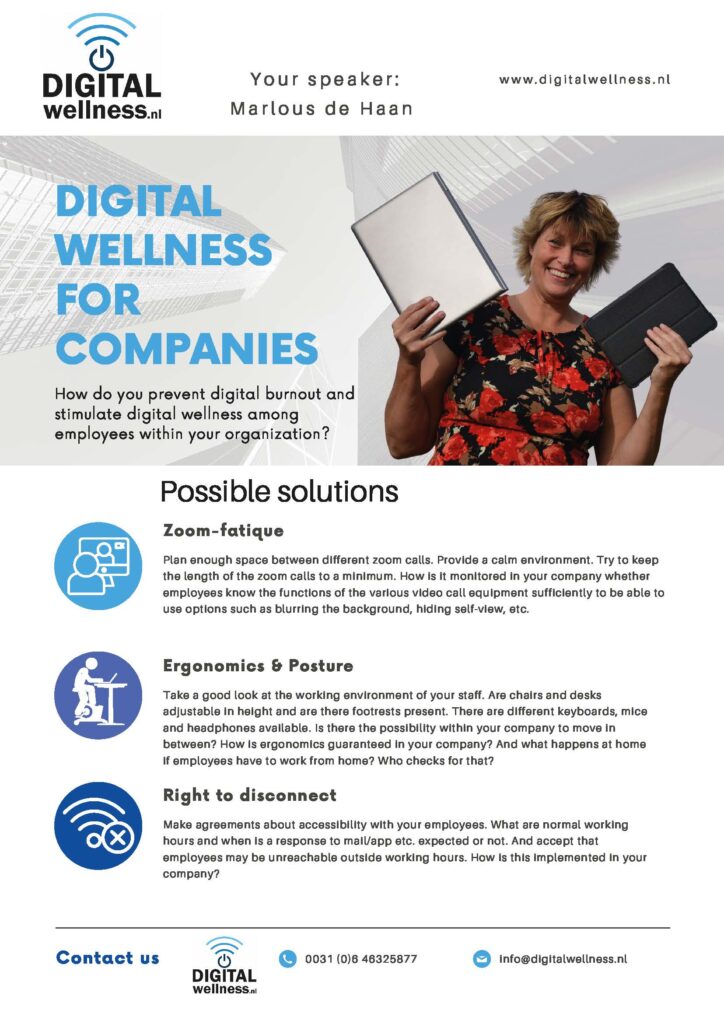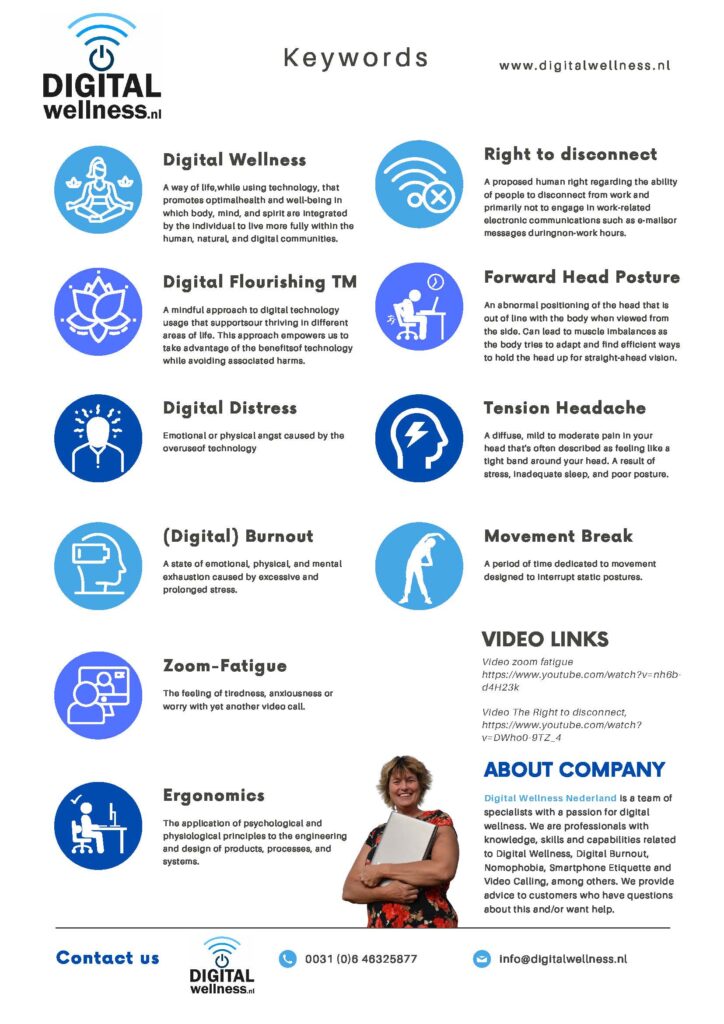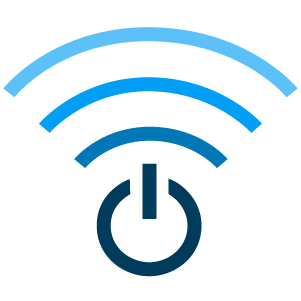This is the text accompanying the slides from the Digital Wellness Institute’s PowerPoint Presentation of The Final Project.
Marlous de Haan
1
NOTES FOR THE DIGITAL WELLNESS INSTITUTE GRADING COMMISSION FROM THIS POWERPOINT:
NOTE 1: EVERYWHERE YOU SEE “NOTE” I GIVE EXTRA INFORMATION ABOUT THE PRESENTATION.
NOTE 2: EVERYWHERE YOU SEE BULLETPOINTS OR A NEW PARAGRAPH, I WANT TO ENTER THAT POINT 1 BY 1 TO AUDIENCE MY PRESENTATION. SO THAT WHAT I SAY APPEARS ON THE PICTURE AND THE LISTENER DOES NOT SEE ALL THE TEXT APPEAR IMMEDIATELY. HOWEVER, I DON’T TURN THAT ON NOW BECAUSE IT WOULD MAKE THE CLICKING THROUGH ENDLESS WHEN CHECKING THIS POWERPOINT.
NOTE 3: BELOW EACH SLIDE IS THE INFORMATION IN SPOKEN TEXT I GIVE WHEN I SHOW THE SLIDE IN THE NOTES. SOMETIMES THERE IS “BACKGROUND INFORMATION IF THE PUBLIC WOULD LIKE TO KNOW MORE OR HAVE OTHER QUESTIONS. HOWEVER, AS MUCH AS I CAN, I DON’T DO THAT.
NOTE 4: HALFWAY YOU CAN SEE 2 VIDEO’S. I WILL ONLY SHOW THE FIRST MINUTE, AS NOTED BELOW.
NOTE 5: THE HANDOUT THAT I DISTRIBUTE AFTER THE PRESENTATION I HAVE INCLUDED IN THE SECOND LAST SLIDE, SO THAT IT IS ALSO VISIBLE FOR THE GRADING COMMISSION OF THE DIGITAL WELLNESS INSTITUTE.
NOTE 6: THE LINKS TO THE RECOURSES OF THE RESEARCH I MENTION IN THIS PRESENTATION IS LISTED ON THE LAST FRAME.
NOTE 7: HAVE FUN READING THIS POWERPOINT!
2
Welcome!
I would like to welcome you to this presentation:
“Digital Wellness for organisations. How do you prevent digital burnout and stimulate sigital wellness among employees within your organisation.”
3
I’ll introduce myself first.
My name is Marlous de Haan.
I am the owner of Digital Wellness Netherlands.
As a physiotherapy scientist I have studied the physical, mental and social problems caused by the use of mobile devices.
I specialize in nomophobia, the addiction to the smartphone.
And yes, I am a hardcore nomophobe myself.
I am the author of the books Smartphone Etiquette and Video Calling Etiquette.
NOTE: I’LL BE SHOWING THE BOOKS IN MY HAND SHORTLY
4
As you sit here, as people working in HR, you all have contact with the care for staff within your company. This can be within all kinds of different organizations, such as the business community, government, healthcare institutions and education, etc. But also the medium-sized company, where there is not an HR department immediately, but where this falls under, for example, a management or owner. Your binding factor is that you are responsible for the well-being of employees. This includes the ever-expanding field of Digital Wellness.
What is Digital Wellness? The definition of Digital Wellness is – “A way of life, while using technology, that promotes optimal health and well-being in which body, mind and spirit are integrated by the individual to live more fully within human, natural and digital communities.”
Translated to your organization, that is striving for an intentional and healthy relationship with technology in the workplace and in personal life. At present, a lot of work and daily activities are highly dependent on digital devices and the internet. And certainly after almost two years of living in the corona pandemic, the time we spend there has increased enormously.
The goal of Digital Wellness is to balance the experience of using technologies such as the Internet and digital devices with a healthy lifestyle in everyday life and to promote healthy user habits
5
To a large extent we are neither used nor trained in sitting in front of a screen all day. As a human that is unnatural. New/young employees grow up more with screen use, but for the many older employees it still takes some getting used to. The almost two years in the corona pandemic have not made it any better. Suddenly we were forced to make even more use of digital tools and accept even longer screen times. Digital working (from home or the workplace) has increased enormously in a very short time. And now? We can no longer do without the digital devices, we have to. But it’s wriggling. The healthy balance between digital technologies and the physical, present tense and world is often hard to find. But the balance between work and private life is no longer as sharp as it used to be. We are always available via e-mails and apps.
As a result of this digital overload of technology overuse, the threat of Digital Distress and Digital Burnout is lurking. And the consequences of a Digital Burnout are significant: happiness at work, productivity and well-being of people decrease, absenteeism and job changers increase, and ultimately the income for the organization can be significantly lower.
A 2020 study by Robert Waters Group Company found that 68% of employees have a need for more freedom in work-life balance and 28% would like to have a greater understanding of mental health and work-life balance. There’s work to be done!
6
This presentation has 3 learning objectives for you:
1) Recognizing the symptoms and expression possibilities of digital distress and Digital Burnout
2) Learning a few examples that can lead to digital burnout in employees.
3) Some possible solutions to prevent Digital Burnout and stimulate digital wellness in your organization
7
The Digital Wellness Institute in the US has summarized all the pillars of Digital Wellness with the Digital Flourishing Wheel.
What is Digital FlourishingTM – A mindful approach to digital technology usage that supports our thriving in different areas of life. This approach empowers us to take advantage of the benefits of technology while avoiding associated harms.
The different pillars are:
Productivity
Environment
Communication
Relationships
Mental Health
Physical Health
Quantified Self
Digital Citizenship
8
This presentation focuses on 4 pillars in particular:
Productivity (improving focus, dealing with distractions, work life balance)
Environment (optimizing physical workplaces, ergonomic office design)
Communication (digital culture at work, tech-life balance & boundaries, socially responsible correspondence)
Physical health (breaks and movement, technical hygiene, ergonomics and posture)
9
What is Digital Distress
Digital distress – The emotional or physical angst caused by the overuse of technology.
Digital Distress is the harbinger of Digital Burnout.
Here you start to get consciously or unconsciously, physically and/or mentally, from a little to more and more irritated by the digital technologies and environment.
If you do nothing now, there is a chance that it will lead to a Digital Burnout.
10
What is a Digital Burnout?
Burnout – Is a state of emotional, physical and mental exhaustion caused by excessive and prolonged stress.
You speak of a Digital Burnout if this situation is caused by prolonged exposure to digital platforms and technologies.
The consequences of a Digital Burnout due to the increased use of digital technologies include attention problems, behavioral problems and mental and physical health problems.
Symptoms include:
Fatigue and decreased physical energy and
Insomnia, headaches and muscle aches
Loss of attention and loss of concentration
Loss of motivation and decline in professional performance
Stagnation in enthusiasm for work, frustration, disengagement and ultimately anxiety or depression.
11
Digital Flourish in your organization is important because a higher degree of Digital Wellness for your employees (and also for yourself) can result in several positive factors for the company. I’ll name a few:
Commitment -A greater involvement of your employees with the company.
This creates a healthy corporate culture with happier employees (and therefore a greater chance of satisfied customers). But also employees who stay with you and become ambassadors for your company. Research by Citrix in 2019 found that 84% of employees consider a good work-life balance to be essential for job satisfaction. Digital Wellness is an essential part of this balance.
Healthier employees, both physically and mentally.
This results in a reduction of exhaustion and a lower risk of absenteeism and dropout.
An improvement in productivity
Often linked to higher revenues for the organization.
12
Poll: By means of a few personal questions that are not about the employee, but that are applicable to your own situation, I would like to ask you to reflect on what you have just heard.
You can answer this with yes or no in your mind.
Do you spend more than 50% of your working time online?
Have you ever sighed “another zoom meeting”?
Can you fully adapt your own working environment to your own wishes? (Seat height, standing or sitting work, mouse and keyboard etc)
Are you able to move for half an hour during working hours? (walking, sports, exercise bike etc)
Are you available after working hours?
NOTE: AFTER THIS I WILL TALK ABOUT THE ANSWERS AND GIVE AND FEEDBACK!!
13
A few examples that are important in whether or not Digital Burnout arises:
Zoom Fatigue
Ergonomics and posture
The Right to Disconnect
I explain them in more detail:
14
I now show you a short film about zoom-fatigue.
NOTE: I only show the first minute!!! So from 00:00:00h to 00:01.01h
Video zoom fatigue, the first minute from 00:00:00h to 00:01:01h
- So the first example is Zoom-fatigue.
What is Zoom-Fatigue?
Zoom-Fatigue: The feeling of tiredness, anxiousness or worry with yet another video call.
There is a lot to be said about Zoom-Fatigue, which is of course also possible with any other video calling software. I’ll keep it short here. Stanford University conducted research into this in 2021. There are 5 areas in which you can experience problems, whether or not combined, if you use too much video calling: Emotional, Motivational, Visual, Social and General Fatigue. This is due to 4 reasons why you can get an overload with video calling:
Excessive close-up eye contact is very intense.
Watching yourself continuously in real time during video chats is exhausting.
Video chats drastically reduce our usual mobility.
The cognitive load is much higher in video chats.
The 2019 Workplace Productivity Report among office workers indicates that 87% stare at screens on average 7 hours a day. More than half reported fatigue and depression as a result of digital overload. The corona pandemic has accelerated the problem. Monster.com’s July 2020 survey of employees who had to work from home reported that 69% reported signs of burnout. In the survey they conducted 3 months earlier, that number was almost 20% lower.
KEEP BACK IN CASE OF QUESTIONS:
ZEF-Scale:
Emotional fatigue refers to feeling overwhelmed and exhausted after interacting with other people.
Motivational fatigue refers to the motivation to start an activity and feel active.
Visual fatigue is how you perceive your vision or visual distress.
Social fatigue refers to the feeling of wanting to be alone after interacting with other people.
General fatigue refers to the superordinate experience of being tired.
16
The second example is about ergonomics and posture.
What do we mean by ergonomics?
Ergonomics – The application of psychological and physiological principles to the engineering and design of products, processes and systems.
If this is not in order, a work environment can cause problems and complaints can arise.
For example, think of:
An adjustable desk chair and possible footrest
An adjustable work surface (standing table is also possible)
Screen size and placement (monitor arm present?)
(Ergonomic) mouse and (ergonomic) keyboard
17
Next to ergonomics stands posture.
What can be the consequences of a wrong posture?
A wrong attitude and work attitude can have many consequences, for example:
Forward Head Posture –
An abnormal positioning of the head that is out of line with the body when viewed from the side. Can lead to muscle imbalances as the body tries to adapt and find efficient ways to hold the head up for straight-ahead vision.
Tension Headache –
A diffuse, mild to moderate pain in your head that’s often described as feeling like a tight band around your head. A result of stress, inadequate sleep and poor posture.
But also a multitude of other complaints that I will not go into here now, such as:
RSI complaints – tendon irritations
Backache
Postural complaints – cramps
tablet neck
Eye problems
Concentration disorders
Obesity
Bad night’s sleep
Etcetera.
18
Another important item is the movement-break.
Movement Break – A period of time dedicated to movement designed to interrupt static postures.
The lack of the opportunity to occasionally move, even during work, has many consequences on both a mental and physical level.
Your brain needs to occasionally relax and process processes. Productivity and storage options are greater if there is an occasional (movement) break.
Physically, sitting for a long time in one position is the recipe for all kinds of physical complaints, as mentioned above. Moving in between prevents a large part of the occurrence of this.
19
I will now show you a short film about the Right to Disconnect
NOTE: I only show the first minute!!! So from 00:00:00h to 00:00:55h
Video The Right to disconnect, the first minute from 00:00:00h tm 00:00:55h
20
- A last example that I give that is important for whether or not a Digital Burnout occurs is:
The Right to Disconnect – A proposed human right regarding the ability of people to disconnect from work and primarily not to engage in work-related electronic communications such as emails or messages during non-work hours.
France was the first country to include this in a bill in 2016. Then Spain, Italy and Belgium follow. Outside of Europe, Chile and Argentina introduced legislative proposals in 2020. Attempts have been made to pass these bills in the Philippines, the US, Canada and India, but unfortunately without success.
On January 21, 2021, the European Parliament adopted a legislative initiative on the right to disconnect. The initiative recommends implementing an EU directive that would allow those who work digitally outside their working hours to disconnect without ill effects.
In order to guarantee the health of employees, it is necessary that employees, but also employers, can keep work and private life separate and have the right to be absent.
21
The solution to a Digital Burnout can be found in applying tools and practices that moderate the use of technologies and promote healthier living and working.
I am going to give solution examples for this, which are in line with the examples of the problems I mentioned earlier.
Namely the Zoomfatigue, the Ergonomics & Posture and the Right to Disconnect
22
Possible solutions against zoom fatigue are:
Pause – Plan enough space or pause between different zoom calls.
Environment – Provide a quiet environment.
Duration – Try to keep the length of the zoom calls minimal and optimal.
Instruction – How is it monitored in your company whether employees know the functions of the various video call equipment sufficiently to be able to use options such as blurring the background, hiding self-view, distance to screens, etc.
23
Possible solutions for good ergonomics and posture at work are:
Workplace – Take a good look at the work environment of your staff.
Seat – Are chairs and desks adjustable in height and are footrests present?
Equipment – Different keyboards, mice and headphones are available.
Moving – Is there the possibility within your organization to take a movement brake? Is this encouraged?
Yoga – Or maybe some Yoga exercises to do? Guarantees – How is ergonomics guaranteed in your organization?
Working from home – And what happens at home, if employees have to work from home?
Control – Who controls that?
IF NESSECARILY IF QUESTIONED:
Yoga – A combination of breathing exercises, physical poses, and meditation used to calm the nervous system and balance body, mind, and spirit.)
24
Possible solutions for the Right to Disconnect are:
Agreements – Make agreements about accessibility with your employees.
Working hours – What are normal working hours and when is a response to e-mail/app etcetera. expected or not.
Unavailability – Accept that employees may be unreachable outside working hours.
Implementation – How is this implemented in your company?
25
Look at yourself in your organization. What is the situation at your work? Think of:
How many hours per week are spent on online meetings?
How many hours a day do your employees sit in front of your PC?
Does your company offer the possibility to exercise during working hours?
And are there rules in your company regarding accessibility and inaccessibility outside working hours?
NOTE: A discussion can arise as a result of the answers. I want to take the time for this.
26
Resume of this presentation:
Awareness! – Recognize and recognize what Digital Wellness can mean for your employees and the importance of preventing a Digital Burnout.
Action! – Make sure you put Digital Wellness high on your list.
Implementation! – Take a number of measures that will improve Digital Wellness within your company.
Here I have a handout for you where the keywords and the mentioned possible solutions to stimulate digital wellness in your organization and to prevent digital burnout are ready for you.
NOTE: I HAVE PREPARED A HANDOUT OF THE KEY POINTS OF THIS PRESENTATION. THIS I WILL DISTRIBUTE AFTER THE PRESENTATION.
27
Thank you very much for your attention. If you want to know more or want to contact me, here is my e-mail address and website where you can reach me.
www.DigitalWellness.nl
Info@digitalwellness.nl
The illustrations used in this presentation are from the books Smartphone Etiquette and Video Calling Etiquette by Marlous de Haan and are copyrighted.
28
NOTE:
This is the HANDOUT I hand out after the presentation. Printed on both sides on A4 size. So that the most important points can be checked at home and there is always the possibility of contact.


